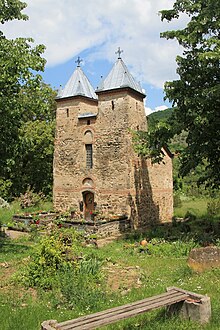
Back Donja Kamenica Püha Jumalaema kirik Estonian Église de la Mère-de-Dieu de Donja Kamenica French Богородичната црква во Доња Каменица Macedonian Богородичина црква у Доњој Каменици Serbian
| Church of the Holy Mother of God | |
|---|---|
| Црква Свeте Богородице Църква „Света Богородица“ | |
 The 14th-century Church of the Holy Mother of God in Donja Kamenica | |
| 43°29′13.48″N 22°19′37.19″E / 43.4870778°N 22.3269972°E | |
| Location | Donja Kamenica, 10 to 15 kilometres (6.2 to 9.3 mi) southeast of Knjaževac, Serbia |
| Denomination | Serbian Orthodox |
| Previous denomination | Bulgarian Orthodox |
| History | |
| Dedication | Holy Mother of God |
| Architecture | |
| Functional status | active |
| Style | Byzantine with Hungarian or Transylvanian influences |
| Completed | early 14th century |
| Specifications | |
| Number of domes | 1 |
The Church of the Holy Mother of God (Serbian: Црква Свeте Богородице / Crkva Svete Bogorodice; Bulgarian: Църква „Света Богородица“, Tsarkva „Sveta Bogoroditsa“) is a medieval Eastern Orthodox church in the village of Donja Kamenica in Knjaževac Municipality, Zaječar District, eastern Serbia. The church is generally considered to have been built in the 14th century, when this area was part of the Second Bulgarian Empire's Vidin appanage, though alternative datings have been proposed.
While small, the Church of the Holy Mother of God is notable for its unusual architectural style, in particular for its high narthex flanked by two sharp-pointed towers. These features, which hint at Hungarian or Transylvanian influences, are highly atypical for medieval Bulgarian church architecture. The church is richly decorated on the inside, with as many as eleven frescoes of historical figures. One of these portraits, captioned as a despot, is variously identified as an eponymous son of Bulgarian tsar Michael Shishman or as an undocumented son of co-tsar Michael Asen IV; earlier speculation that the image depicted Serbian noble Mihailo Anđelović or Michael Shishman himself have since fallen out of favor with art historians. In addition to these early portraits, the interior walls of the church were painted with canonical murals, which can stylistically be assigned to the 14th–15th century. The church was reconstructed in 1958 and has been under Serbian state protection since 1982.
© MMXXIII Rich X Search. We shall prevail. All rights reserved. Rich X Search
